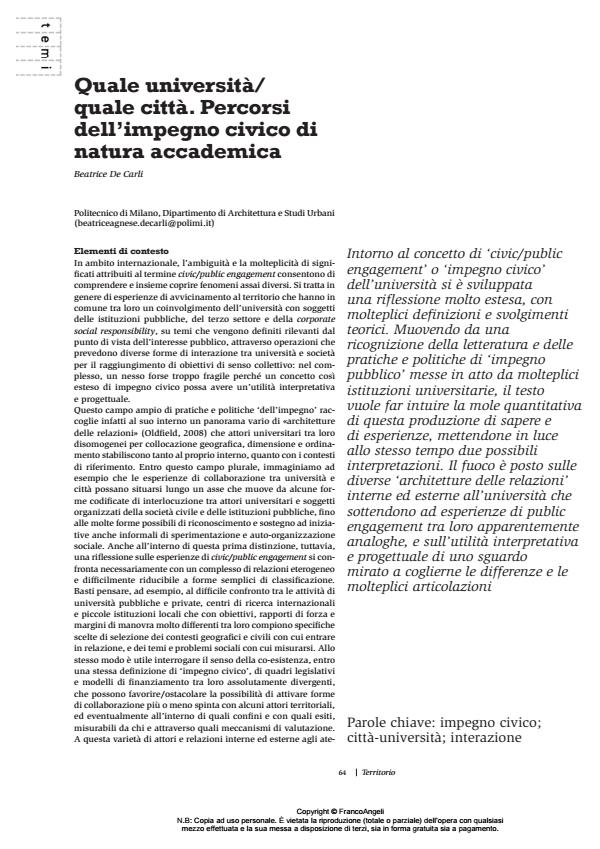Which university/which city. Civic commitment paths of an academic nature
Journal title TERRITORIO
Author/s Beatrice De Carli
Publishing Year 2013 Issue 2013/66 Language Italian
Pages 5 P. 64-68 File size 147 KB
DOI 10.3280/TR2013-066014
DOI is like a bar code for intellectual property: to have more infomation
click here
Below, you can see the article first page
If you want to buy this article in PDF format, you can do it, following the instructions to buy download credits

FrancoAngeli is member of Publishers International Linking Association, Inc (PILA), a not-for-profit association which run the CrossRef service enabling links to and from online scholarly content.
Very extensive discussion has developed around the concept of ‘civic/public engagement’ or ‘civic commitment’, with a great variety of definitions and theoretical approaches. The paper starts with a survey of the literature and of the ‘public commitment’ practices and policies currently pursued by many universities and then seeks to convey an idea of the huge quantity of this production of knowledge and experiences, highlighting at same time two possible interpretations. The focus is on the different ‘relationship architectures’ inside and outside universities which underlie public engagement experiences that are apparently similar to each other and also on the usefulness to interpretation and planning of an eye that seeks to grasp the differences and the great variety.
Keywords: Civic commitment; city-university; interaction
- Bawa A., 2007, «Rethinking The Place of Community-Based Engagement at Universities», in McIlrath L. and Mac Labhrainn I. (eds.), Higher Education and Civic Engagement: International Perspectives, Ashgate, London, pp. 55-65.
- Boland J., 2011, «Positioning Civic Engagement on the Higher Education Landscape: Insights from a Civically Engaged Pedagogy», Tertiary Education and Management, vol. 17, n. 2, pp. 101-115, DOI: 10.1080/13583883.2011.562523
- Butin D.W., 2003, «Of what use is it? Multiple Conceptualizations of Service Learning within Education», Teachers College Record, vol. 105, n. 9, pp. 1674-1692, DOI: 10.1046/j.1467-9620.2003.00305.x
- Castelnuovo I., Cognetti F., 2013, «The Double Responsibility of Public Engagement. Reflections from the Polisocial Program», in Nash E.J., Brown N.C., Bracci L. (eds.), Intercultural Horizons: Intercultural Strategies in Civic Engagement, Cambridge Scholars Press, Cambridge.
- Cornwall A., 2002, «New Democratic Spaces? The Politics and Dynamics of Institutionalised Participation», IDS Bullettin, vol. 35, n. 2, pp. 1-10, DOI: 10.1111/j.1759-5436.2004.tb00115.x
- Cornwall A. and Schattan Coelho V., 2007, Spaces for Change? The Politics of Citizen Participation in New Democratic Arenas, Zed Books, New York.
- Edwards M., 2007, «Love, Reason, and the Future of Civil Society», in McIlrath L. and Mac Labhrainn I. (eds.), Higher Education and Civic Engagement: International Perspectives, Ashgate, London, pp. 13-25.
- Furco A., 2007, «Institutionalising Service-Learning in Higher Education», in McIlrath L. and Mac Labhrainn I. (eds.), Higher Education and Civic Engagement: International Perspectives, Ashgate, London, pp. 65-82.
- Furie M., 2003, «Beyond the Ivory Tower: Service Learning for Sustainable Community Development», South African Journal for Higher Education, vol. 17, n. 1, pp. 31-38.
- Garcia Lamarca M., 2011, «Implementing the Right to the City in Brazil», in Polis – A Collaborative Blog About Cities Across The Globe (thepolisblog.org/2011/10/implementing-right-to-city-in-brazil.html).
- Honnet E.P. and Poulsen S., 1989, Principles of Good Practice in Combining Service and Learning. Wingspread Special Report, Johnson Foundation, Racine, WI.
- Howard J. and McKeachie W., 1993, Praxis: A Faculty Casebook on Community Service Learning, Ocsl Press, University of Michigan, Ann Arbor.
- Jacoby B., 2003, Building Partnerships for Service-learning, Jossey-Bass, San Francisco, CA.
- McIlrath L. and Mac Labhrainn I., 2007, eds., Higher Education and Civic Engagement: International Perspectives, Ashgate, London.
- Negri A., 2003, «Conversation with Charles Guerra», Grey Room, vol. 11, Spring, pp. 86-109.
- Oldfield S., 2008, «Who’s Service Whom? Partners, Process, and Products in Service-Learning Project in South African Urban Geography», Journal of Geography in Higher Education, vol. 32, n. 2, pp. 269-285, DOI: 10.1080/03098260701514215
- Paba G., 2009, «Partecipazione, deliberazione, auto-organizzazione, conflitto », in Paba G., Pecoriello A.L., Perrone C., Rispoli F., Partecipazione in Toscana. Interpretazioni e racconti, Firenze U.P., Firenze, pp. 15-52.
- Watson D., Hollister R., Stroud S.E., Babcock E., 2011, The Engaged University: International Perspectives on Civic Engagement, Routledge, London.
- Wiewel W., Broski D., 1997, University Involvement in the Community. Developing a Partnership Model (web.pdx.edu/~wubbold/EcoImpact08/Partnership%2520model.pdf).
- Young I.M., 2000, Inclusion and Democracy, Oxford U.P., Oxford-New York.
- Ricerca-azione e università. Produzione di conoscenza, inclusività e diritti Francesca Cognetti, in TERRITORIO 78/2016 pp.40
DOI: 10.3280/TR2016-078004
Beatrice De Carli, Quale università/ quale città. Percorsi dell’impegno civico di natura accademica in "TERRITORIO" 66/2013, pp 64-68, DOI: 10.3280/TR2013-066014